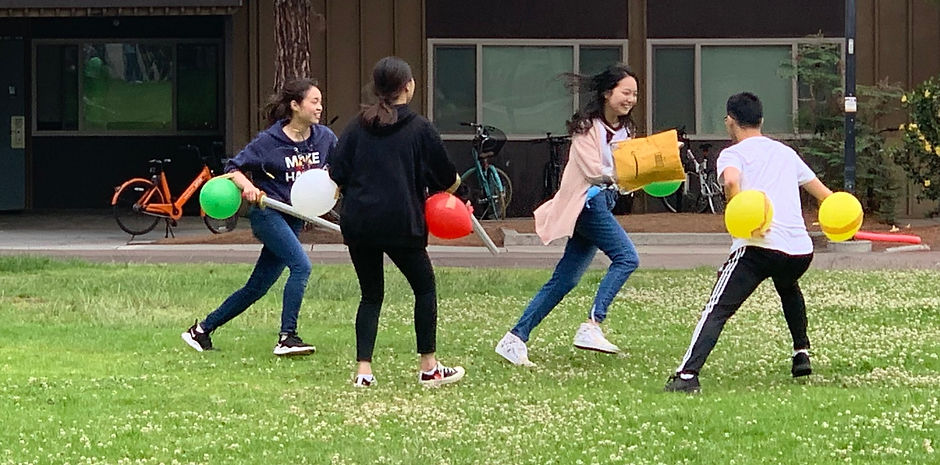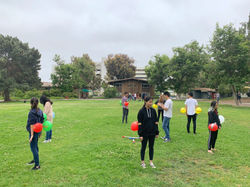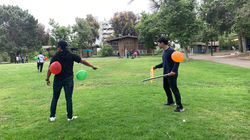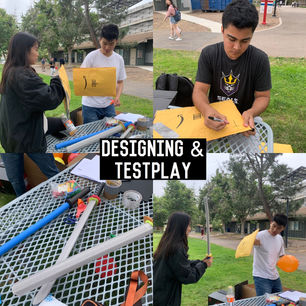
in dependence
game & simulation experiment (2019)
In Dependence is a live action role playing simulation where players are pitted together in a Hunger Games-like fashion. The game incorporates swords and shields, a safe zone, balloons, as well as a candy collecting game mode. Although, there is a twist, an element of experimentation. We designed this simulation to discover the different playing dynamics. Will people depend on complete strangers to get the optimal win or will their natural instincts be to defend themselves when facing a war-like situation? Our game implements an effective icebreaker, exercise, and a look into human psychology.

Design Group Statement
Our creative goals included making an exciting physical game that could create a simulation in which players can immerse themselves in, while challenging the extent of their collaboration in times of franticness. We wanted to bring to life a real-life war simulation that would not be dangerous at all, thus we got inspiration from different battle games. The main game that was the most influential to our game is Hunger Games. Like the craziness of the beginning of the Hunger Games, we imitated the manic so that players can be distracted by the message of the actual game. We placed a “cornucopia” of our own by putting the important key swords in a pile, and having everyone face outside in a circle surrounding it. That way, they have a choice to go on the offense or run on the defense. This game builds on the idea of darkplay that we learned from class. The fact is our players are playing a surface-level game, but with the hidden meaning of teamwork in a time of madness, our players are actually being tested in another type of game. It tests against the psychology of our players, seeing if instinct or intellect is the first choice.
When designing our simulation we experienced many changes in our design. Our team kept revising and improving the instructions. When we first started the design, the location at Sixth Residence Halls’s grass field was picked to make the game seem like the Hunger Games; they were out in the wild grass field with rewards and tools scattered around. The grassy area was the battle field, the tables were the safe zones, and the grass was tall enough to hide the candy. It was the perfect place to set up.We also were planning to give everybody a sword and shield. However, we wanted our simulation to cover the critical aspect of working together and uniting as a team. By giving everybody a sword and shield, it was more like a sword fight. If everybody had a weapon and sword they will be against each other, there would be no reason to team up. By noticing that aspect of the simulation, we decided to allow the player to only have a weapon or shield, they cannot have both items on hand. We were expecting people with shields to depend on a person with a sword. Then, we noticed that we needed to add another player goal, so we added the objective of collecting as much candy in 20 minutes.
We raised incentives to wanting to win, which augments the natural instinct in humans to become more competitive and more energized with adrenaline. By raising the stakes, the possibility of the players being able to team up decreased, but we wanted to replicate the feeling of real war, where everything is incredibly hectic and no one has the chance to think about the underlying meaning of what is happening. We pasted hints in hopes that those with shields would congregate together and decipher the riddle, so that they could all work collaboratively to win the game, and evenly share the candies.
While playtesting, we could not emulate the hidden surprise of the message, so instead we focused on the physical aspects of the game, such as how the balloons would pop, especially if we cannot use sharp objects to poke the balloons. We considered the hazards of each material we used, and decided to go with a foam sword to minimize any harm that could be done, and with playtesting, we realized that these swords in fact work perfectly with the balloons; it was both challenging but possible to pop the balloons that resembled lives in game.
Outside of playtesting, on the day of simulation, we had the chance to finally figure out how the psychological parts of the game would work out. Surprisingly, a lot of different routes were taken that we did not even fathom of. For example, because the preparation of balloon tying took a while, we accidentally did not explain the rules thoroughly enough, and the players went wild with things like having 2 shields and 1 sword, etc. It was exciting to see the rush of the players, but also no one had the chance to notice the hints on the shields. They only focused on the war-battle aspect. In the end, one player realized what was on the shields and tried to mediate with the other player. Turns out, it was only a ruse to make the other players think while the player attacks.
The second simulation was more organized, but the energy was not there until the end. People were reluctant to swing the sword. People also noticed the shield, but took no action whatsoever. What’s even more surprising is that the people with the swords were the ones working together. The ones who were helpless, one with the shields, did not even stick together to figure out the hidden message, nor to defend each other from the tyranny of swords. We found that there were so many types of playing dynamics, that went differently than the black and white options we placed on the game. We thought it would be either win alone or win all together, but there is so much more intriguing outcomes from this game.
We believe that not only is this a great psychology experiment, but it also is a great game for an icebreaker! We hope that this game can become replicated and used many more times as a fun activity and also a challenge to peoples’ idea of teamwork and collaboration.
game setup
Location:
Sixth Res Halls grass quad (half)
Game Duration:
25 to 40 minutes - 2 rounds
Number of Players:
6-10
Safe zone located by seats - maximum of 2 people at one time; maximum of 2 minutes in a safe zone; once a player leaves they cannot return for 1 minute
5 shields located around the environment - each of them have hints written on them, 3 of which must be connected to create a message
3 swords placed in the middle pile that players huddle around back to back at the start of the game
Candies scattered all throughout the play area
Each person has 2 balloons strapped to their arms, which represent their lives

game rules
guidelines that players have to follow during simulation
Players CANNOT move their own balloons
You win the game by surviving AND having the most candy --- if you win you get to keep the candy
Eliminate players by knocking or popping both of their balloons
Each player can only have 1 sword or shield at any given time
You can run around with a sword using 1 hand but if you’re battling another person you must use 2 hands
Players cannot use their bare hands or shield to pop balloons
If a sword player eliminates another sword player then that eliminated player carries their sword out of the game AND drops their candy
If a sword player eliminates a shield player then that shield player drops their shield AND their candy
Stray balloons CANNOT be picked up
No groin shots/overly aggressive behavior (battering people, tackling, head-butting, elbowing/ramming into people and such)
Players can stay at a Safe Zone for max of one minute, and after must stay one minute outside of the safe zone
Players must stay in the game zone
materials, design parameters, planning
play-testing, ups and downs, the ultimate development of this experimental simulation
game materials
sharpies, duct & clear tape, empty amazon packages, foam swords, balloons, string, chocolate candies, grass field/play area

design parameters
mimicry, agon, and a mix between ludus and paidia:
players must have some freedom of choice while orienting them towards our critical element

planning
link to our brainstorming and planning process: https://docs.google.com/presentation/d/1299O9mcySf3fThIPosO1CFa-YmRbY_1_0e89YeuNM5g/edit?usp=sharing


about us
tech = trish, eric, christine, hanley
trish
web developer / designer / executioner
Trish is one of the four creators of the invigorating simulation "in dependence" offered in Ash Smith's CAT 3 class of the year 2019. She dedicated her time to brainstorming ideas for the game theme, setup, and meaning behind the scene. She helped the team by constructing shields and blowing balloons as well as setting up the venue of the game. She offered multiple perspectives in what could improve as the team worked on play-testing. She is the creator of this website, and the communicator between her team and the professor (a.k.a named as the lead according to Professor Smith).
eric
moderator / designer / executioner
Eric worked as one of the head designers and contributed many integral ideas for the simulation. He was the main communicator with Casey to finalize game elements, including sword and shield mechanic, rules, and hints. He created the shields and set up many game mechanics. He took responsibility in bringing game materials in its finalized form. Eric also was the main moderator of the game, taking notes on the game dynamics as it was being played.
christine
photographer / designer / executioner
Christine, an integral part of the team, was in charge of buying materials. She made sure to get the swords and balloons. Also, she elaborated on making the amazon packages as shields. She contributed on developing another aspect for the simulation, which was adding the goal of collecting chocolate bars. Lastly, she took pictures during design and play testing.
hanley
mechanics designer & developer / executioner
One of the project leads, Hanley brainstormed the idea of simulating war and exploring the dynamics between dependence and independence tendencies in people when placed in a competitive environment. He determined the tools used to represent lives (balloons) and filter interactions between players (sword and shield). Also, he though about adding the objective to streamline the win condition of the simulation (candy bar collection).
casey polacheck
teacher assistant / critical influencer / honorable mention
Casey, the team's teacher assistant for the quarter, gave excellent advice on how the team could further the experimental design of their simulation. He contributed by giving critiques to the potential loopholes the simulation carried, and was a primary source of support and help. He was important in growing the underlying message, morale, and narrative of the simulation. In addition, he was great in assisting with gauging the simulation's practicality and ensuring it’s success in effective human dependency exploration.

Our Critical Goal is to create an ambiguity between choices: to win by yourself or with everyone. It is critical because it's seeing if America's positive notion of independency is good or not in this case. Should teamwork be an essential part of life? It is also experimental by seeing if humans are more cooperative or independent.
 |  |  |
|---|---|---|
 |  |  |
 |  |  |
 |  |  |
 |  |  |
 |  |
"It's an exciting and fun game. love it. I noticed what the word says on the shield. But compared with persuading others to evenly distribute the candies, I had to run and the avoid attack from people with sword."
"The game was fun but could have had a little bit of a smaller field and easier to pop the balloons. The game itself was fun but it was a little unfair to only have 3 swords to completely control the entire game."
"It was a really fun game, it was like a real-life Battle Royale game."
"In this game we had very interesting interaction among players and a lot of fun trying to pop balloons on each other. The rules need to be explained more clearly."
"The game was very fun and exciting to play. The only thing is to maybe tweak the instructions."
"The setup took too long. The field of play was too big, so finding candy was a mission."
"Fun game, nice choice of location."
Student Responses
Contact
La Jolla, San Diego, CA, USA

